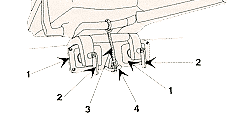It is recommended that you
choose a motor suitable for your principal boating activities. The
recommended and maximum powers are given in the technical
specifications.
The weight of the outboard
The weight of the outboard has a direct effect on the handling of your inflatable.
-
For the same power output, choose the
lighter outboard
-
Check that the engine's weight is compatible with the maximum recommended weight for your boat
Shaft length of the motor (short,
long or extra-long)
Propeller
Your motor may come
equipped with a "standard" propeller. Ask your dealer to
assist you in choosing the optimum propeller for your principal use.
Installing the motor
 - Install the motor along the centerline of the boat, in the middle of
the tightening plate (1) (see diagram)
- Install the motor along the centerline of the boat, in the middle of
the tightening plate (1) (see diagram)
- Fully tighten the brackets (2) by hand and check that they are still
properly tightened after 15 minutes of running.
- Secure the motor to the loop (4) on the motor tightening plate (1)
with a safety cable (3).
Adjusting the tilt of the motor
To get the best
performance and maneuverability, you may have to adjust the tilt (the
angle of the motor to the transom) more often in relation to
navigation conditions.
In a calm sea, the motor
must be positioned so that the axis of the propeller is parallel to
the water. But an adjustment of the tilt is recommended under certain
other conditions:
The adjustment can be
manual or by an electric trim, if supplied with the engine. The trim
is a hydraulic control that inclines the motor in navigation.
Usually:
-
If the motor is
positively trimmed, the boat will porpoise.
-
If the boat is
negatively trimmed, the boat will nose down.
When to use the
positive trim: 
When to use the
negative trim: 
NEVER USE A MOTOR POWER HP
HIGHER THAN INDICATED ON THE MANUFACTURER'S I.D. PLATE AS THIS COULD
RESULT IN LOSS OF CONTROL.



